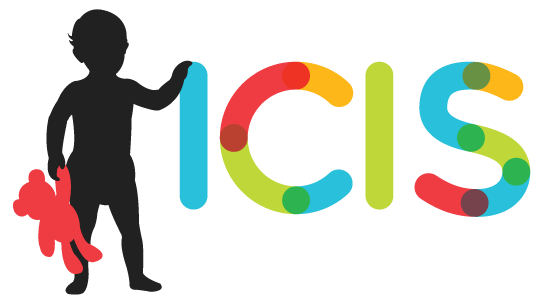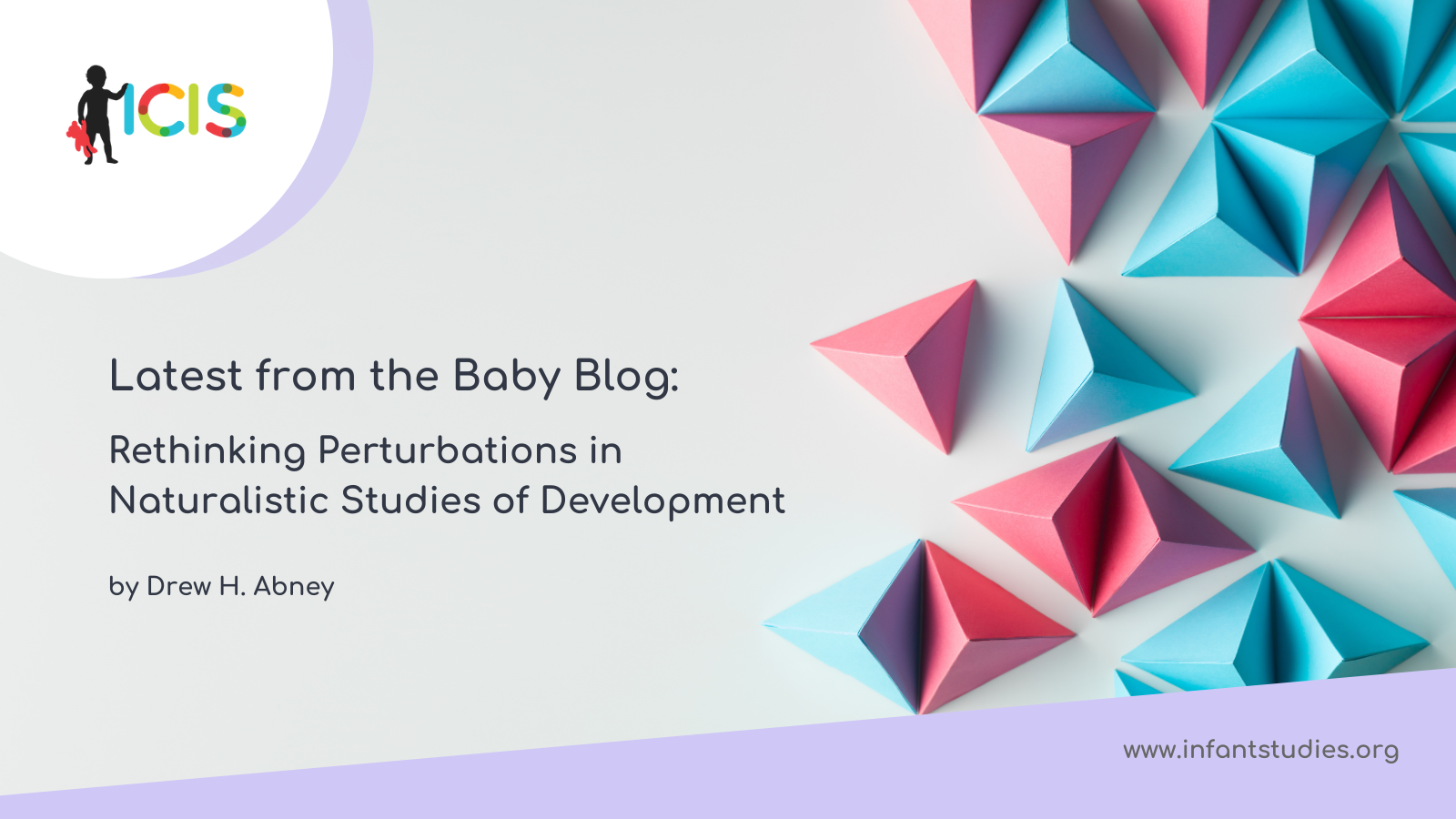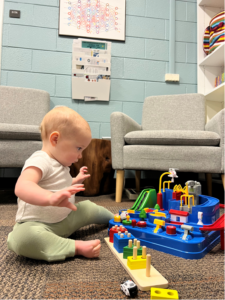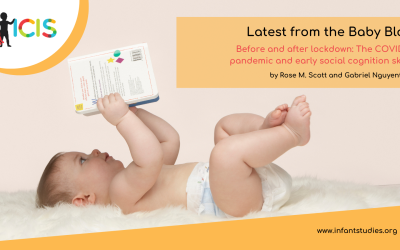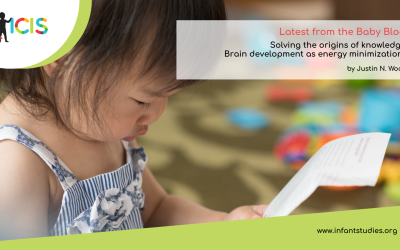Drew H. Abney
University of Georgia
For many decades, some developmental scientists have used the framework of dynamic systems to guide theory and prediction about how human infants change while embedded in a complex, social world. A dynamic systems framework has formal predictions and tools for understanding and explaining change over time. For example, a dynamic systems perspective will consider the developing human infant as a complex system composed of many interacting components embedded within a complex and changing environment. This framework highlights the interesting ways in which components of a complex system (e.g., a human infant) interact and reorganize under the constraints of the environment. For example, the onset of new motor actions pave the way for behaviors across domains: producing a complex vocalization while unsupported sitting, handing a toy to a caregiver with one hand while cruising, stabilizing the head for vision while walking. This approach underscores the importance of developmental change and stability across time scales, challenging infant research programs to leave the causal comforts of the high-controlled laboratory setting and venture into more naturalistic contexts.
As a trend to go ‘outside of the lab’ paints a brighter picture with a brush of ecological realism, what is sorely needed is innovation (or adoption) of how to think about causal mechanism. Whereas a lab environment gives control to a scientist, studying a phenomenon in the real world gives the richness of complexity and increased ecological validity. Is the search for causal mechanism lost for the scientist seeking ecological realism? I do not think so. Parametrizations (or manipulations) of variables in natural environments can inform about causal mechanisms. For example, increasing the number of toys during a toy play session in the home will change behaviors of both infant and caregiver. An infant who can sit unsupported can now reach for objects in new ways and can produce more complex vocalizations. But these empirical strategies do not account for the intrinsic (e.g., a new goal) and extrinsic (e.g., a change in social context) changes that infants are perceiving and producing.
One way that my lab (https://www.devdynlab.us) is starting to think about how systems change is by thinking more deeply about how systems – whether it be an infant’s physiological system, the infant-caregiver dyadic system, or collective behavior of many individuals – react and reorganize in the face of a perturbation event. From a dynamic systems perspective, a perturbation can be an intrinsic or extrinsic event that instigates (or, if we are feeling bold, causes) a system to reorganize itself. A response to perturbation can tell us something about the system: a system that responds quickly to a perturbation and reorganizes itself to then display similar properties as it did before the perturbation event is considered to be a highly stable and flexible system. I am certainly not the first one to offer this idea in developmental psychology: Thelen and Smith (1994) brought up perturbations early in their highly influential book and it has also played out in fascinating ways in the study of emotion regulation across decades (e.g., Ham & Tronick, 2007; Cole, Lougheed, Chow, & Ram; 2020; Gao et al., 2023). But what I am suggesting is that – as we take seriously the new opportunities to collect data in the wild – we consider frameworks that still allow us to think deeply about causal mechanisms.
So, how far can we take the idea of integrating a perturbation framework into studying developmental phenomena? Does it have legs? I think that an empirical perturbation framework would benefit from adopting a few other properties relevant for studying and quantifying flexible, adaptive systems. Bernstein (1967) brought to the foreground the degrees of freedom problem which simply points out that a large set of independent components of a system puts a computational burden on a central nervous system during action production. For example, when producing a reach, it is computationally efficient for independent components of a system (e.g., arm kinematics, eye movements, postural control) to be coordinated. In other words, efficient coordination of components of a system simplifies complex action production. How is the human system able to produce such amazing, complex, coordinated, beautiful actions with so many degrees of freedom? When the degrees of freedom are coordinated, what is considered as dimensional compression (Kay et al., 1987), we can expect a system with many independent components to simplify (by becoming coordinated) to form a lower-dimensional system that affords adaptivity and flexibility. So, bringing this back to the idea of a perturbation event, let’s consider a developmental phenomenon studied for decades: the onset of controlled reaching. We might consider the act of reaching as a perturbation on the multimodal system of the developing infant. We might expect that as an infant becomes a more skilled reacher, degrees of freedom (hand positions, postural stability, eye/head coordination, etc.) become more coupled and we would observe more dimensional compression. Practically we could put numbers to this idea using some quantitative tools many of us are already using. If we had variables that represented kinematics of movements from limb effectors and dynamics of eye movements (hey, even physiological signals…), we could quantify dimensional compression by submitting the multivariate timeseries (i.e., time series of kinematics like hand velocity, time series of angular information from eye movements, and time series of heart rate variability from ECG) dataset to a dimensionality reduction method like Principal Components Analysis, which reduces a larger set of variables (or components) into a smaller one. The idea is that more dimensional compression of the system would be identified with few components explaining more of the system-level variability (e.g., 90% of the variance).
An empirical perturbation framework for studying developmental phenomena may or may not provide a contribution to better understanding causal mechanisms in more real-life contexts and a number of issues would need to be resolved. For example, types of perturbations would need to be better understood. In the classic lab-based Face-to-Face Still Paradigm, the perturbation of the Still Face phase is a clear example of an extrinsic perturbation on the infant-caregiver dyadic system. My previous example of reaching behavior is less clear but points to a rich possibility that considering the onset of classic motor milestones within a framework of unfolding perturbations of differing magnitudes and consequences might provide innovation and contribution to the field.
As a field that cares deeply about change, it’s worth it to continue to challenge and reformulate our empirical frameworks. This is especially true during an exciting period in our science when getting more and more data from naturalistic contexts is becoming easier, cheaper, and more rigorous. As a field, we have always taken seriously the quality of our data. We ought to give the same consideration to the quality of empirical frameworks we use to study and quantify change.
An infant in the Developmental Dynamics Lab poised to execute a controlled reaching action.
References
Bernstein, N.A. (1967). The co-ordination and regulation of movement. Pergamon Press, Oxford.
Cole, P. M., Lougheed, J. P., Chow, S. M., & Ram, N. (2020). Development of emotion regulation dynamics across early childhood: A multiple time-scale approach. Affective science, 1, 28-41.
Gao, M., Vlisides‐Henry, R. D., Kaliush, P. R., Thomas, L., Butner, J., Raby, K. L., … & Crowell, S. E. (2023). Dynamics of mother‐infant parasympathetic regulation during face‐to‐face interaction: The role of maternal emotion dysregulation. Psychophysiology, 60(6), e14248.
Ham, J., & Tronick, E. D. (2006). Infant resilience to the stress of the still‐face: Infant and maternal psychophysiology are related. Annals of the New York Academy of Sciences, 1094(1), 297-302.
Kay, B. A., Kelso, J. A. S., Saltzman, E. L., and Schöner, G. (1987). Space-time behavior of single and bimanual rhythmical movements: data and limit cycle model. J. Exp. Psychol. Hum. Percept. Perform. 13, 178–192.
Thelen, E., & Smith, L. B. (1994). A dynamic systems approach to the development of cognition and action. MIT press.
